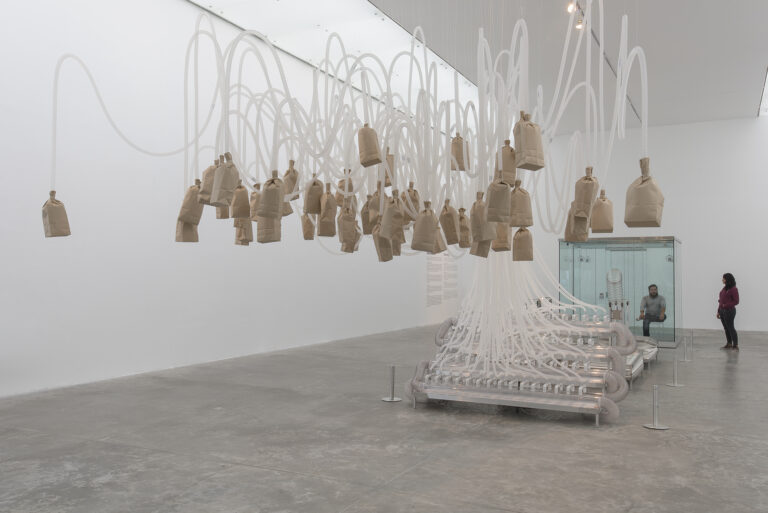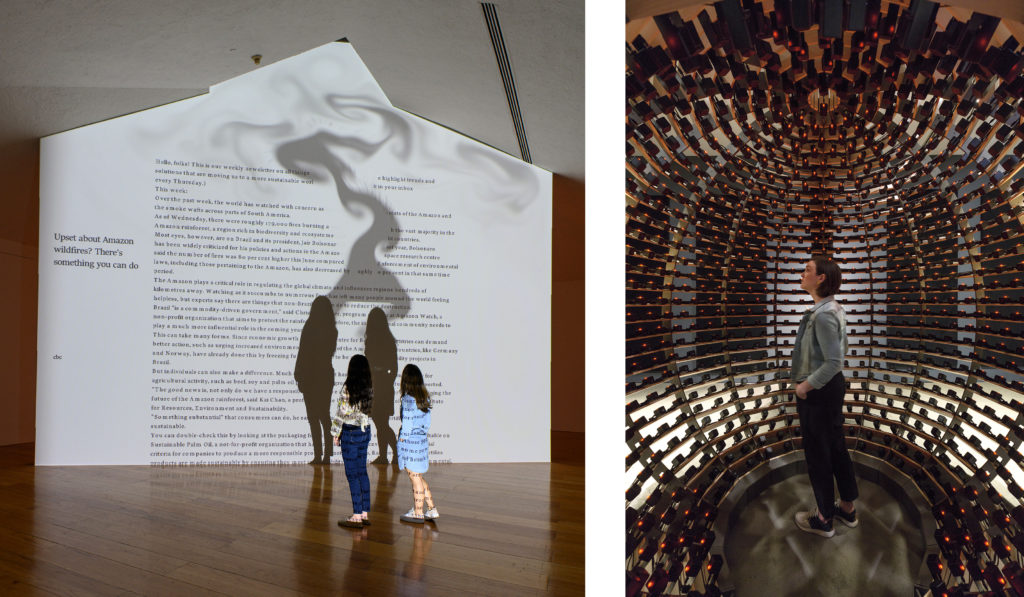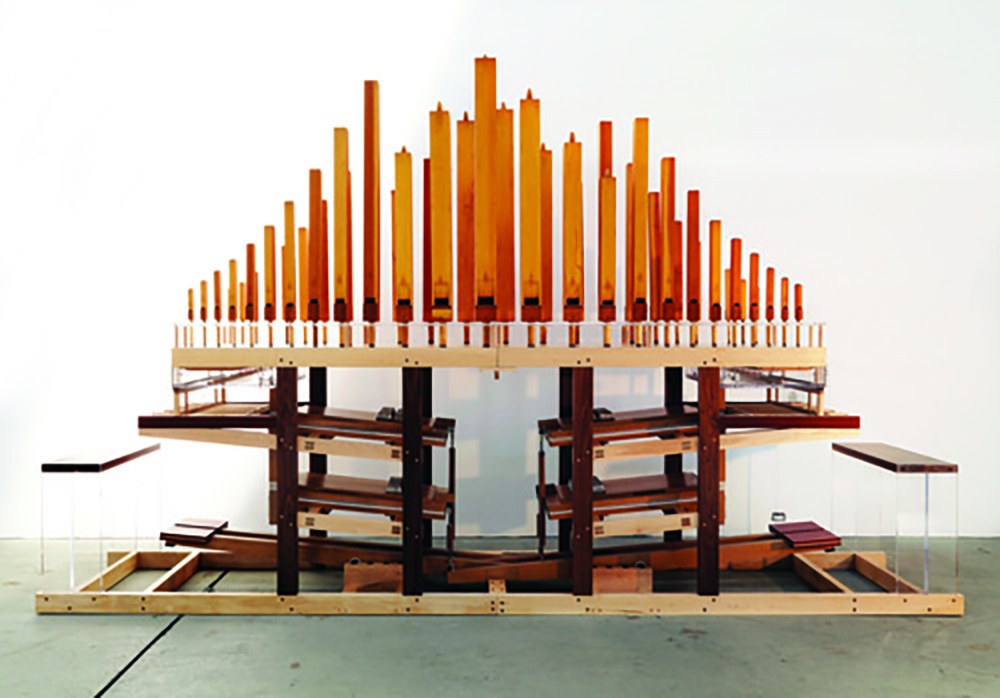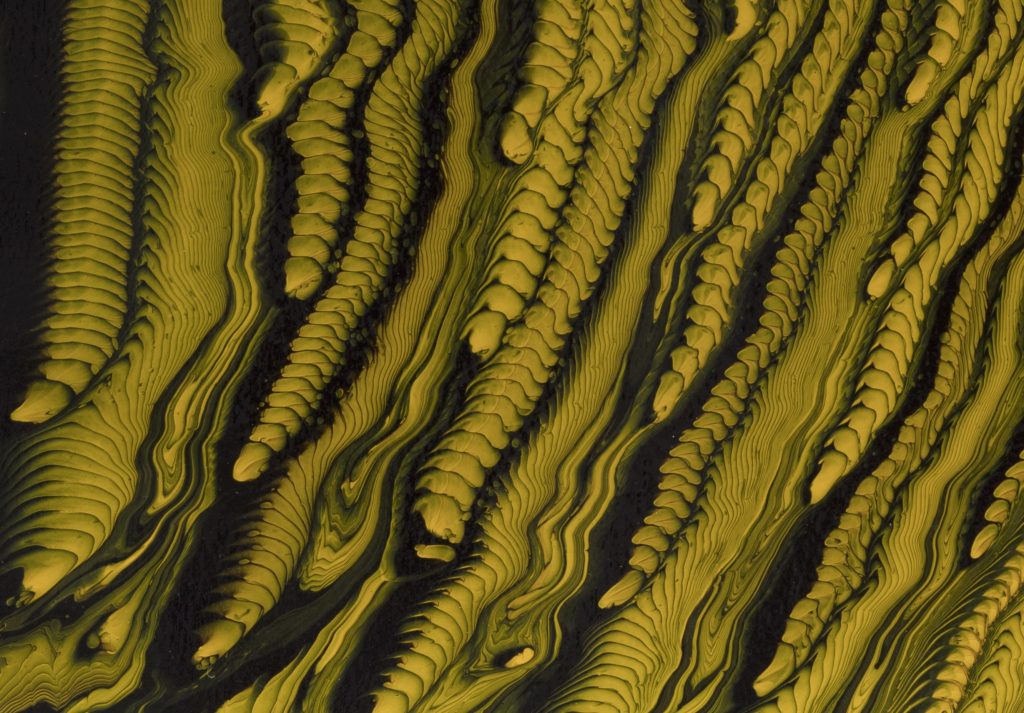
Rafael Lozano-Hemmer, Vicious Circular Breathing, 2013 (installation view, Pseudomatismos, Museo Universitario Arte Contemporáneo, Mexico City, 2015); Borusan Contemporary Art Collection; © Rafael Lozano-Hemmer / Artists Rights Society (ARS), New York / VEGAP, Spain; photo: Oliver Santana
SAN FRANCISCO, CA (November 12, 2019) — The San Francisco Museum of Modern Art (SFMOMA) will present two major exhibitions celebrating the mixed media work of contemporary artists Rafael Lozano-Hemmer and Tauba Auerbach this spring. The artist’s first major survey exhibition in the U.S., Rafael Lozano-Hemmer: Unstable Presence (April 25–November 1, 2020) will explore our presence in fundamentally turbulent environments through a focused selection of 16 engaging installations on the museum’s seventh floor. Simultaneously on the museum’s fourth floor, Auerbach’s first museum survey, Tauba Auerbach — S v Z (April 25–September 7, 2020), will highlight her prolific and varied output over the last 16 years.
Also on view this spring will be select video projections from renowned interdisciplinary artists Cauleen Smith and Theaster Gates in Future Histories (April 25–November 1, 2020).
Rafael Lozano-Hemmer: Unstable Presence
April 25–November 1, 2020
Floor 7
Air and water, heartbeats and voices, text and light — these are the materials of media artist Rafael Lozano-Hemmer. Over the past few decades, the Mexico City–born, Montreal-based artist has earned international recognition for large-scale participatory installations that frequently incorporate technology and the architecture of public spaces. On view in the U.S. exclusively at SFMOMA, Rafael Lozano-Hemmer: Unstable Presence brings together recent sculptural installations and immersive environments realized on microscopic and macroscopic scales. These works engage visitors’ sense of play, and anxiety, as they experience the implications of technology and behaviors of participation in social and political contexts.
“Unstable Presence refers to the dynamic, poetic, but also disturbing turbulence that characterizes social and technical interrelations,” said Rudolf Frieling, curator of media arts at SFMOMA. “Materializing on various scales, from the personal to the geopolitical, the instability of these layers of presence is powerfully echoed in the atmospheric but also sculptural installations.”
Rafael Lozano-Hemmer: Unstable Presence additionally examines the concept of “co-presence” by highlighting how our physical presence and the natural and technological spaces we inhabit form a continuous stream of interaction. Lozano-Hemmer noted, “Presence is often associated with existence, continuity in time or material reality. The ‘unstable’ in the exhibition’s title refers to interaction, improvisation and performance. The instability brought by participation allows constant reinterpretation of the work, where many outcomes are co-present.”
The exhibition focuses on three major themes in Lozano-Hemmer’s work: observation and surveillance; text-based poetic work; and the instability of systems. Highlights of the presentation include the following installations, the majority of which encourage visitor participation:

Rafael Lozano-Hemmer, Sphere Packing: Bach, 2018 (installation view, Unstable Presence, Musée d’art contemporain de Montréal, 2018); Borusan Contemporary Art Collection; © Rafael Lozano-Hemmer / Artists Rights Society (ARS), New York / VEGAP, Spain; photo: Guy L’Heureux
Airborne Newscast (2013) projects live news feeds from prominent international news outlets, such as Reuters, Agencia EFE, Notimex, AlterNet and AP. When visitors enter the space, their shadows disrupt the projections and dissolve the projected words into smoke-like patterns, creating an unstable atmospheric effect.
Call on Water (2016) is a fountain from which words emerge as plumes of vapor, produced by hundreds of computer-controlled ultrasonic atomizers. Fragment by fragment, poems by the celebrated Mexican writer Octavio Paz briefly materialize in the mist before dissipating in turbulence.
Pulse Spiral (2008) consists of hundreds of incandescent lightbulbs hanging from the ceiling in a three-dimensional spiral. This participatory installation records and responds to the heart rates of visitors holding sensors, transforming their heartbeats into mesmerizing flashes of light.
Sphere Packing: Bach (2018), the largest in Lozano-Hemmer’s Sphere Packing series, is a three-meter spherical frame supporting 1,128 loudspeakers, each simultaneously playing a different composition by Johann Sebastian Bach. Visitors can enter the sphere and be surrounded by the cacophonous crescendo of Bach’s entire musical output.
Vicious Circular Breathing (2013) is a large sculptural installation featuring brown paper bags that inflate and deflate at human breathing rates; a set of motorized bellows and valves that control the bags; and a sealed glass room with a decompression chamber. Visitors are invited to enter the glass room to breathe the air that was previously breathed by earlier participants. The piece includes warnings about the risks of asphyxiation, contagion and panic, offering a statement on the limits of the planet’s resources as well as a commentary on participation, which in this case makes the air more toxic for future visitors.
Voz Alta [Out Loud] (2008) commemorates the 40th anniversary of the massacre of hundreds of students in Tlatelolco, Mexico City, on October 2, 1968. The original site-specific “anti-monument” is presented in the gallery as a functional prototype: participants are invited to step up to a megaphone and speak freely, their speech translated into light flashes via a miniature searchlight. An FM radio transmitter relays the sounds to which the light corresponds, and an archival recording of the 2008 memorial plays after a participant has finished speaking. In this way, the memory of the tragedy in Tlatelolco is mixed with live participation.
Zoom Pavilion (2015) is an interactive installation created in collaboration with artist Krzysztof Wodiczko. Consisting of projections fed by computerized surveillance footage, the work uses face recognition and other tracking algorithms to detect the presence of participants and record their spatial relationships. Independent cameras zoom in to amplify images with up to 35x magnification. The zooming sequences become disorienting as they change the image landscape from easily recognizable wide shots of the crowd to abstract close-ups.
About Rafael Lozano-Hemmer
Rafael Lozano-Hemmer was born in Mexico City in 1967, and lives and works in Montreal. He was the first artist to represent Mexico at the Venice Biennale. He has also shown at biennials and triennials in Cuenca, Havana, Istanbul, Kōchi, Liverpool, Melbourne, Montreal, Moscow, New Orleans, New York, Seoul, Seville, Shanghai, Singapore, Sydney and Wuzhen. Lozano-Hemmer’s works have been featured in solo exhibitions and performances in numerous institutions, including the Museo Universitario Arte Contemporáneo (MUAC) in Mexico City (2015); SFMOMA (2012); the Museum of Contemporary Art, Sydney (2011); the Manchester Art Gallery (2010); the Guggenheim Museum, New York (2009); and the Barbican Centre, London (2008).
Catalogue
Rafael Lozano-Hemmer: Unstable Presence is accompanied by a catalogue featuring full-color illustrations of works in the exhibition and contributions covering a range of topical approaches. It includes a curatorial introduction and four essays from Olivier Asselin, Sean Cubitt, Tatiana Flores and Gloria Sutton that explore the poetic and political dimensions of the artist’s work, along with in-depth examinations of four major works — Zoom Pavilion, Vicious Circular Breathing, Voz Alta and Pulse Room. Edited by Rudolf Frieling and François LeTourneux, the catalogue is published by the San Francisco Museum of Modern Art in association with Delmonico Books/Prestel.
Venues and Dates
Musée d’art contemporain de Montréal (MAC): May 24–September 9, 2019
Museo de Arte Contemporáneo de Monterrey (MARCO): August 23, 2019–March 1, 2020
San Francisco Museum of Modern Art (SFMOMA): April 25–November 1, 2020
Organization + Support
Rafael Lozano-Hemmer: Unstable Presence is co-organized by the San Francisco Museum of Modern Art and the Musée d’art contemporain de Montréal. The exhibition is co-curated by Rudolf Frieling, curator of media arts at SFMOMA, and Lesley Johnstone, curator and head of exhibitions and education at the MAC, with François LeTourneux, associate curator.
Generous support for Rafael Lozano-Hemmer: Unstable Presence is provided by Lionel F. Conacher and Joan T. Dea, Debbie and Andy Rachleff, Carlie Wilmans, and Pat Wilson.

Tauba Auerbach — S v Z
April 25–September 7, 2020
Floor 4
Tauba Auerbach studies the boundaries of perception through an art and design practice grounded in math, science and craft. Her multifaceted interests often focus on issues of duality, interconnectedness, rhythm and form, and intersect with questions about the structure of the universe. This exhibition, the San Francisco native’s first museum survey, spans 16 years of her career and highlights the relationships between the range of media and concepts she engages. Included are compositions that explore the properties of letters and symbols; drawings, books and large-scale installations that complicate binary relationships; trompe l’oeil paintings that experiment with depth and dimension; weavings and glass sculptures embedded with various waveforms; and videos that interpret theories in quantum physics.
“Auerbach moves fluidly across disciplines and interests,” said Joseph Becker, SFMOMA associate curator of architecture and design, “from developing tools and methodologies for her paintings and sculptures which play upon our perceptions of space and time, to probing semiotics and design with her work in typography and architectural ornament.”
“Auerbach is one of those rare artists who has the ability to open numerous worlds at once by connecting her exploration of the symbolic capacity of geometric form to concepts and fields that expand our understanding of nature, our anatomy and consciousness,” continued Jenny Gheith, SFMOMA assistant curator of painting and sculpture.

The immersive presentation will be designed by Auerbach, along with an in-depth catalogue that serves as both an artist book and an index of work, process and references, created in collaboration with graphic designer David Reinfurt. The subtitle S v Z encapsulates Auerbach’s longstanding consideration of symmetry and texture, key aspects of her practice that are represented in both the exhibition and the catalogue’s design, including the typeface and layout.
A comprehensive survey of Auerbach’s practice, this exhibition will explore several fundamental themes including language, ornament, flow, logic, the helix and time. Major bodies of work featured in the presentation will include:
Auerglass Organ (2009)
The Auerglass Organ is a two-person collaborative pump organ created by Tauba Auerbach and the musician Cameron Mesirow (also known as Glasser). The Auerglass will be performed throughout the run of the exhibition.
Folds (2009–13)
The Fold paintings are an exploration of dimensionality and the technical process of painting, comprising trompe l’oeil compositions that give the appearance of being three-dimensional while existing on a flat canvas.
Weaves (2012–15)
In the Weaves series, Auerbach explores the materiality and structure of canvas itself by creating interwoven surfaces that form complex patterns based on architecture and light.
Grain (2017–present)
The Grain paintings are created with custom-made tools that Auerbach drags through layers of color, resulting in canvases that are embedded with ornamental and fractal forms read through the physicality of gesture.
Diagonal Press (2013 to present)
Diagonal Press is the artist’s imprint for open-editioned publications, including books, typographic specimens, jewelry and mathematical toys.
About Tauba Auerbach
Tauba Auerbach was born in San Francisco, California in 1981, and lives and works in New York. Though best known for painting, Auerbach works in a variety of media including weaving, glass, photography, 3D printing, typeface design, book-making and musical instrument design. In 2013, she founded Diagonal Press to formalize her ongoing publishing practice. Auerbach was awarded SFMOMA’s SECA Art Award in 2008, marking her first solo museum presentation. Since then, her work has been internationally recognized and featured in solo exhibitions and performances in New York, London, Oslo and Sweden.
Catalogue
Tauba Auerbach — S v Z is accompanied by a fully illustrated 256-page catalogue designed by the artist in collaboration with graphic designer David Reinfurt and co-published by Distributed Art Publishers, Inc. The publication features a typeface designed specifically for the project that slants from left to right as the pages progress. It serves as both an artist book and an index of work, process and references.
S v Z Public Program
Accompanying the exhibition will be a performance and lecture program that features Auerglass (2009) and highlights key interdisciplinary themes and concepts from Auerbach’s survey exhibition.
Support
Major support for Tauba Auerbach — S v Z is provided by Gay-Lynn and Robert Blanding and SFMOMA’s Collectors’ Forum. Generous support is provided by Martha and Bruce Atwater, Joachim and Nancy Hellman Bechtle, Jim Breyer and Angela Chao, Katherine Harbin Clammer and Adam Clammer, Fotene Demoulas and Tom Coté, Roberta and Steve Denning, the Elaine McKeon Endowed Exhibition Fund, Gina and Stuart Peterson, The Sanger Family Architecture and Design Exhibition Fund, Lydia Shorenstein, Sheri and Paul Siegel, and Sonya Yu and Zachary Lara. Meaningful support is provided by Thomas and Lily Beischer, Dolly and George Chammas, and Agnes Gund.

Future Histories: Theaster Gates and Cauleen Smith
April 25–November 1, 2020
Floor 7
Bringing together the work of two interdisciplinary artists, this presentation will center on video projections that use archival journalistic photography as a point of departure. The U.S. premiere of Theaster Gates’s Do you hear me calling? Mama Mamama or What Is Black Power? (2018) will explore the idea of the Black Madonna by reworking three decades of images drawn from the Johnson Publishing Company archives, which includes Ebony and Jet magazines. In this two-channel video installation, Gates interweaves scenes of musicians and singers, including the artist and his ensemble, amplifying a performative approach to cultural legacies. This year a consortium of foundations acquired the archives for The Getty Research Institute and the Smithsonian National Museum of African American History and Culture.
Cauleen Smith’s Sojourner (2018) culminates with a feminist reimagining of an unpublished photograph from a 1966 Life magazine assignment. Throughout this film, banners with phrases conveyed by American jazz musician Alice Coltrane Turiyasangitananda are used in performances by women at different sites associated with community organizing or artistic vision, such as the outdoor desert assemblages of Noah Purifoy in California. Smith’s film Lessons in Semaphore (2015), where choreographer taisha paggett uses flags to activate a vacant lot in Chicago, will also be on view. Presented in conjunction with this exhibition will be film programs including the Bay Area debut of Smith’s audiovisual performance Black Utopia LP (2012) on May 21, 2020 in SFMOMA’s Phyllis Wattis Theater.
Support
Meaningful support for Future Histories: Theaster Gates and Cauleen Smith is provided by Wayee Chu and Ethan Beard.